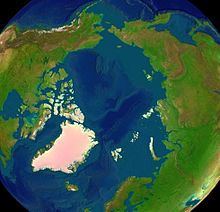This article is missing information about the Arctic Desert. (February 2024) |




The Arctic (/ˈɑːrktɪk/ or /ˈɑːrtɪk/)[1][Note 1] (from Greek ἄρκτος, 'bear') is a polar region located at the northernmost part of Earth. The Arctic region, from the IERS Reference Meridian travelling east, consists of parts of northern Norway (Nordland, Troms, Finnmark, Svalbard and Jan Mayen), northernmost Sweden (Västerbotten, Norrbotten and Lappland), northern Finland (North Ostrobothnia, Kainuu and Lappi), Russia (Murmansk, Siberia, Nenets Okrug, Novaya Zemlya), the United States (Alaska), Canada (Yukon, Northwest Territories, Nunavut), Danish Realm (Greenland), and northern Iceland (Grímsey and Kolbeinsey), along with the Arctic Ocean and adjacent seas. Land within the Arctic region has seasonally varying snow and ice cover, with predominantly treeless permafrost under the tundra. Arctic seas contain seasonal sea ice in many places.
The Arctic region is a unique area among Earth's ecosystems. The cultures in the region and the Arctic indigenous peoples have adapted to its cold and extreme conditions. Life in the Arctic includes zooplankton and phytoplankton, fish and marine mammals, birds, land animals, plants and human societies.[3] Arctic land is bordered by the subarctic.
- ^ a b "The American Heritage Dictionary entry: arctic". www.ahdictionary.com. Houghton Mifflin Harcourt. Archived from the original on 12 June 2018. Retrieved 4 January 2019.
- ^ Harper, Douglas. "Antarctic". Online Etymology Dictionary. Archived from the original on 13 January 2012. Retrieved 16 November 2011.
- ^ Krembs, Christopher and Jody Deming. "Organisms that thrive in Arctic sea ice." Archived 23 March 2010 at the Wayback Machine National Oceanic and Atmospheric Administration. 18 November 2006.
Cite error: There are <ref group=Note> tags on this page, but the references will not show without a {{reflist|group=Note}} template (see the help page).